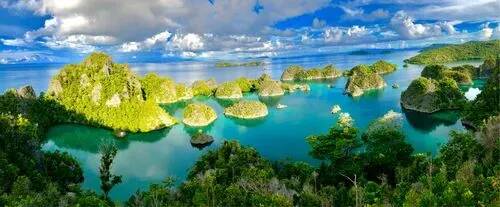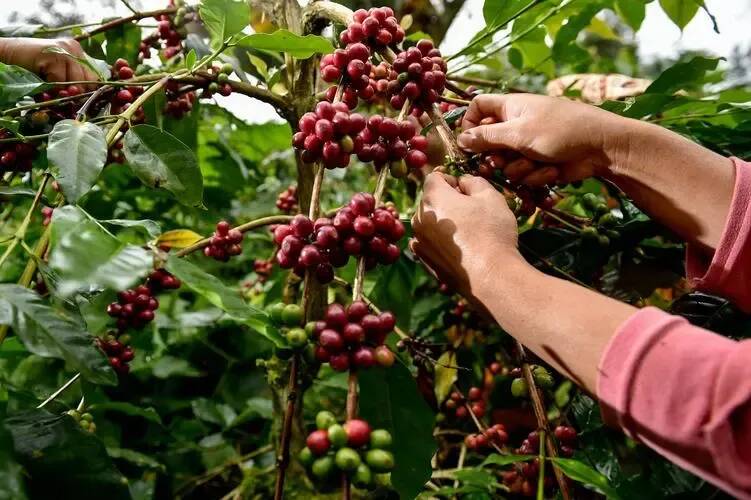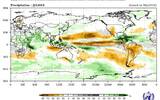Introduction to Java Island, Indonesia's coffee producing area
Asia is the largest and most populous continent of the seven continents, with ups and downs, high in the middle and low in the surrounding. Mountains, plateaus and hills account for a large area. And the Asian continent spans the cold, warm and hot zones, and the climate types are complex and diverse. It can be said that many Asian countries are suitable for growing coffee, including the "land of ten thousand islands" and Indonesia.

As early as the 17th century, the Dutch colonial government planted the first coffee trees near Batavia (now Jakarta) in Indonesia. Although these seedlings were destroyed in a flood, the seedlings of the second time succeeded in bearing fruit and thrived here.
By the early 18th century, the ships of the Dutch East India Company exported the first batch of coffee from the port of Java to Europe. Since then, the Indonesian government has exported thousands of pounds of coffee every year. At the time, Arabica varieties were grown in Indonesia, but in the 1860s, coffee leaf rust (CLR) destroyed most of Indonesia's coffee production. So most farmers replaced Arabica with Robusta, which is more disease-resistant and easier to grow. Currently, the Robusta exhibition accounts for 85% of the total coffee production in Indonesia, while Arabica accounts for 15%.

Indonesia is now the fourth largest coffee producer in the world. Such a high production is due to its rich natural resources. Indonesia is made up of 17508 islands and is the largest archipelago country in the world, spanning Asia and Oceania. Indonesia straddles the equator and has a tropical rain forest climate. The climate is warm and humid throughout the year. The average temperature is between 25 ℃ and 27 ℃ degrees. It is divided into dry and wet seasons because of the monsoon.
The country's volcanic country, with more than 500 volcanoes, many rivers, lakes and forests, with a forest coverage of 67.8%, is an ideal area for growing coffee. At present, coffee trees are planted in many islands in Indonesia, and coffee producing areas are also divided into islands, such as Sulawesi, Bail, Java and Sumatra.
Among them, the most famous is Sumatra, which is also the largest island in the country, known as "Manning". But there are also good coffee beans in Java. The well-known coffee variety Java was introduced from Ethiopia to the Indonesian island of Java in the early 19th century and was named after the island of Java when it was introduced to other countries.
Java, located in the south of the equator, is the fifth largest island in Indonesia. The island is long and narrow as a whole, with mountains and hills, mostly broad basins, rivers, and more than 100 volcanoes, so the island has fertile soil and good natural conditions. it is still a developed agricultural area with an arable land rate of 70%. The island is also the first area in the country to grow coffee.
The island consists of West Java, Central Java, East Java and the old capital of Jakarta (the new capital Nusangtala was relocated in 2024) and Yogyakarta, while coffee is grown throughout the island, in the Preanger region of West Java, and in Central Java, in Banjar Negara, Wonosobo and Temanggung, all around the Merapi volcano and in East Java. The largest and most important area on the island, coffee is grown around the Bromo and ljen volcanoes.
Planted at elevations between 900 and 1800, there are many varieties, such as Iron pickup Typica, Timor Tim Tim, Katim Ateng (local name), USDA 762, etc.
Important Notice :
前街咖啡 FrontStreet Coffee has moved to new addredd:
FrontStreet Coffee Address: 315,Donghua East Road,GuangZhou
Tel:020 38364473
- Prev

Many countries around the world experience high temperature weather! Coffee production declines in many producing countries
Recently, media from many places around the world reported that many countries around the world encountered hot and hot weather after entering summer. According to the Global Seasonal Climate Update (GSCU), in all areas outside the eastern Pacific near the equator, sea surface temperatures are generally higher than normal, and this situation will continue. Therefore, almost all
- Next

How to make three-dimensional 3D flower? How to use the carved needle of latte coffee? When was the drawing technology of espresso coffee invented?
In "Why are lattes so popular?" In this article, Qian Jie introduced that since coffee lahua was discovered and spread, sales of dairy coffee have soared. The so-called coffee drawing is to use milk foam to draw various patterns on the surface of the coffee. But you know, coffee actually
Related
- Customers have "changed" Manner's new products! Shop assistant: Please don't mess around!
- Remove sockets in customer areas at Starbucks stores?! Netizen: I won't go if I really tear it down
- What is the difference between the taste steps of sun-dried coffee and washed coffee? Why is sun-cured coffee sweeter and washed coffee sour?
- The recipe for salty grapefruit dirty is revealed! Coffee Festival salty grapefruit dirty coffee making materials parameters ratio milk share!
- How about the flavor of Sunlight 74158 at Sidamo Banshaha Mathieu Processing Factory in Ethiopia? 74158 Share the proportion of coffee brewing parameters!
- What effect does Italian American coffee with filter paper have? Will coffee taste better if it is put on filter paper at the bottom of the powder bowl?
- What is the color difference in coffee beans? What are the characteristics of honey processed coffee beans? Why are the anaerobically treated coffee beans uneven in color?
- How does novice Xiaobai quickly get started and make coffee? Newbies learn to make coffee by hand and share the specific steps and process process!
- Costa tea has a shelf life of 100 years?! Expert: Unable to verify
- It's a huge uproar! American milk addition was rejected by Manner employees?!

